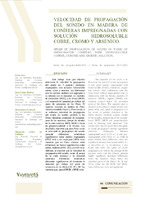Velocidad de propagación del sonido en madera de coníferas impregnadas con solución hidrosoluble cobre, cromo y arsénico
Speed of propagation of sound in wood of impregnated conifers with hidrosoluble copper, chrome and arsenic solution
| dc.rights.license | Licencia de Creative Commons Reconocimiento-NoComercial-CompartirIgual 4.0 Internacional (CC BY-NC-SA 4.0) | |
| dc.creator | Pan, Estela Margarita | |
| dc.creator | Medina, Juan Carlos | |
| dc.creator | Umlandt, Maximiliano Carlos | |
| dc.creator | Juárez de Galíndez, Margarita del Carmen | |
| dc.date.accessioned | 2020-10-23T16:53:58Z | |
| dc.date.available | 2020-10-23T16:53:58Z | |
| dc.date.issued | 2018-12-01 | |
| dc.identifier.citation | Pan, E. M., Medina, J. C., Umlandt, M. C., y Juárez de Galíndez, M. del Carmen (2018). Velocidad de propagación del sonido en madera de coníferas impregnadas con solución hidrosoluble cobre, cromo y arsénico. Yvyraretá: Revista Forestal País de Árboles. Eldorado (Misiones): UNaM. FCF; (26), pp. 66-75. | es_AR |
| dc.identifier.issn | 2469-004X | |
| dc.identifier.other | Yvy-007 | |
| dc.identifier.uri | https://hdl.handle.net/20.500.12219/2641 | |
| dc.identifier.uri | http://www.yvyrareta.com.ar/index.php/component/k2/item/373-velocidad-de-propagacion-del-sonido-en-madera-de-coniferas-impregnadas | |
| dc.description | Fil: Pan, Estela Margarita. Universidad Nacional de Santiago del Estero. Facultad de Ciencias Forestales; Argentina. | es_AR |
| dc.description | Fil: Medina, Juan Carlos. Universidad Nacional de Santiago del Estero. Facultad de Ciencias Forestales; Argentina. | es_AR |
| dc.description | Fil: Umlandt, Maximiliano Carlos. Universidad Nacional de Santiago del Estero. Facultad de Ciencias Forestales; Argentina. | es_AR |
| dc.description | Fil: Juárez de Galíndez, Margarita del Carmen. Universidad Nacional de Santiago del Estero. Facultad de Ciencias Forestales; Argentina. | es_AR |
| dc.description.abstract | Este trabajo tiene por objetivo determinar la velocidad de propagación del sonido en 2 especies madereras impregnadas con solución hidrosoluble cromo, cobre y arsénico; sus diferencias con las mismas maderas sin impregnar y su relación con la densidad, los módulos de elasticidad (MOE), y de rotura (MOR) y el contenido de humedad por debajo del punto de saturación de las fibras. El material utilizado es madera de Pinus elliottii variedad elliottii y Pinus taeda, y se midieron velocidad de propagación del sonido en sentido paralelo a las fibras, densidad, contenido de humedad, peso de las muestras, tiempo de tránsito de la onda acústica, MOE, MOR y límite de proporcionalidad a la flexión. Los resultados muestran que para Pinus taeda la velocidad de propagación del sonido presentó diferencias estadísticas significativas entre madera impregnada (5118 m/s) y sin impregnar (4026 m/s), mientras que en Pinus elliottii, estas diferencias no fueron significativas entre ambas maderas (4881 m/s) y (4194 m/s). Además, se encontró que la velocidad de propagación del sonido, como el pasaje de la onda acústica y la densidad presentan diferencias estadísticas altamente significativas al disminuir la humedad por debajo del punto de saturación de las fibras (30, 20 y 10 %), mientras que, para el MOR y MOE estas diferencias no fueron significativas. | es_AR |
| dc.description.abstract | The objective of this work is to determine the speed of sound propagation in two wood species impregnated with water soluble solution, chromium, copper and arsenic; their differences with the same wood without impregnation and its relationship with the density, modulus of elasticity (MOE), rupture (MOR) and moisture content below the saturation point of the fibers. The material used is wood of pinus elliottii variety elliottii and pinus taeda, and speed of propagation of the sound in parallel direction to the fibers, density, moisture content, weight of the samples, transit time of the acoustic wave, MOE, MOR and proportionality limit to bending were measured. The results show that for pinus taeda the speed of sound propagation showed significant statistical differences between impregnated wood (5118 m / s) and non-impregnated wood (4026 m / s), while in pinus elliottii these differences were not significant between both woods (4881 m / s) and (4194 m / s). In addition, it was found that both, the speed of sound propagation, as well as the passage of the acoustic wave and the density, present highly significant statistical differences when the humidity drops below the saturation point of the fibers (30, 20 and 10%), while for the MOR and MOE, these differences were not significant. | en |
| dc.format | application/pdf | |
| dc.language.iso | spa | es_AR |
| dc.publisher | Universidad Nacional de Misiones. Facultad de Ciencias Forestales. Secretaría de Ciencia, Técnica y Posgrado | es_AR |
| dc.rights.uri | http://creativecommons.org/licenses/by-nc-sa/4.0/ | |
| dc.source | Yvyraretá: Revista Forestal País de Árboles, 12-2018; (26): pp. 66-75 http://yvyrareta.com.ar/index.php | |
| dc.subject | Velocidad de propagación del sonido | es_AR |
| dc.subject | Pinus elliottii var. Elliottii | es_AR |
| dc.subject | Pinus taeda | es_AR |
| dc.subject | Maderas impregnadas y sin impregnar | es_AR |
| dc.subject | Speed of spread of the sound | en |
| dc.subject | Pinus taeda | en |
| dc.subject | Impregnated wood and without impregnating | en |
| dc.title | Velocidad de propagación del sonido en madera de coníferas impregnadas con solución hidrosoluble cobre, cromo y arsénico | es_AR |
| dc.title | Speed of propagation of sound in wood of impregnated conifers with hidrosoluble copper, chrome and arsenic solution | en |
| dc.type | info:eu-repo/semantics/article | |
| dc.type | info:ar-repo/semantics/artículo | |
| dc.type | info:eu-repo/semantics/publishedVersion |
Files in this item
This item appears in the following Collection(s)
-
Revista Yvyraretá [360]




